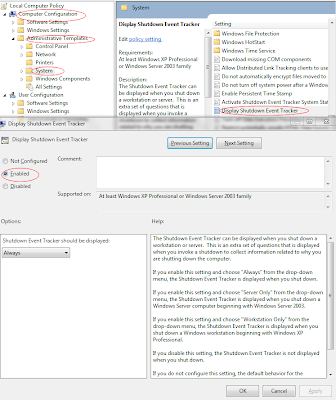- Select start and enter gpedit.msc into search box and run the editor
- Go to Computer Configuration/Administrative Templates/System
- Then choose Display Shutdown Event Tracker and Enable.

Unintelligible posts on .Net, Usability and web technology


As in previous posts, I like to annually report on browser stats that I collect via the Intranet web apps that I develop. Knowing your target browser platform is crucial when developing web sites, affecting your designs, client side functionality and testing criteria. So here are May 2010’s stats, taken from a 1229 user global application (across 87 countries), all of whom have logged on in the last 12 months (Corporate desktop for the company concerned is still IE6 as I write this, sigh…):
| Browser Version | User Count 2010 (1229 users) | User Count 2009 (1017 users) |
|---|---|---|
| IE6 | 1116 | 973 |
| IE7 | 77 | 33 |
| IE8 | 27 | 2 |
| Firefox | 7 | 8 |
| Chrome | 2 (new entry!) | NA |
IE5 no longer shows thank goodness and a high count for IE6 is expected (default desktop install remember). Great to see IE8 in there which should rapidly rise by 2011 as it is likely to be adopted globally soon in the Company concerned. Firefox has gone down and in my opinion will continue to drop with it offering little over Chrome/IE8 for day to day browsing (gone too bloaty). Reminder: these stats are from what the user used for a particular web app only - the user may well have other browsers installed for general browsing.
Window sizes:
| Viewable window size (pixel width) | User Count 2010 | User Count 2009 |
|---|---|---|
| less than 800 | 18 | 23 |
| 800 exactly | 28 | 63 |
| 801 to 899 | 22 | 28 |
| 900 to 999 | 26 | 22 |
| 1000 to 1099 | 492 | 489 |
| 1100 to 1199 | 51 | 35 |
| 1200 to 1299 | 272 | 135 |
| 1300 to 1399 | 21 | 1 |
| 1400 to 1499 | 68 | 52 |
| 1500+ | 15 | 5 |
These figures were captured at logout time (assuming that by then the user would have their browser sized/maximised to their preference for the application). Looking at the figures, clearly larger windows sizes are on the up and smaller sizes are on the down (surprise surprise). The “design for 1024” philosophy still seems to hold to a point but the “1200+ size” users are on the increase. There are still 94 users viewing windows at less than 1000 though, something the web application concerned, it has to said, does not look its best at! Hey ho, something to ponder on…
Clarkey
I enjoy seminars, conferences etc. Whether presenting or attending, chosen carefully, they provide a great way of sparking interest in new methods and technologies, putting aside some time for training/education (essential if you work for yourself as I do) and meeting other like-minded individuals.
Here are a couple of upcoming events I’ve recently registered for:
SPA-237 - Agile Adoption Anti-Patterns“… focuses on the things that you shouldn't do when trying to introduce Agile practices to an organisation”
This is a free evening session and is being presented by James Lewis from the well respected consultancy Thoughtworks. I’m a big fan of Agile approaches, but there are issues you have to watch out for and hopefully this event will get some of these aired.
DevWeek 2010
15th to 19th March 2010, London
The conference blurb… “DevWeek is Europe’s leading independent conference for software developers, database professionals and IT architects, and features expert speakers on a wide range of topics, including .NET 4.0, Silverlight 3, WCF 4, Visual Studio 2010, REST, Windows Workflow 4, Thread Synchronization, ASP.NET 4.0, SQL Server 2008 R2, LINQ, Unit Testing, CLR & C# 4.0, .NET Patterns, WPF 4, F#, Windows Azure, ADO.NET, Entity Framework, Debugging, T-SQL Tips & Tricks, and more”
I’ve been to one of these previously and from what I remember they are slick and very well organised, with the sessions containing some great material. Although clearly Microsoft centric, if you use (or intend to use) such technologies, you could do a lot worse than attend this.